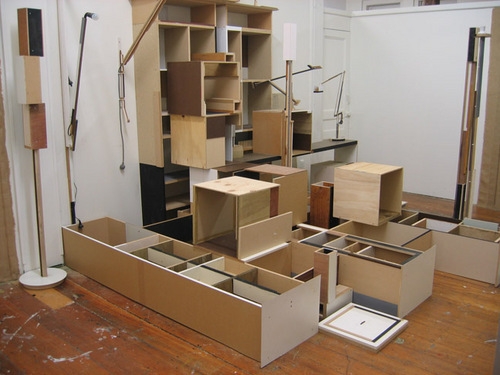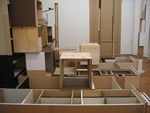Jason Lindsay at Special Gallery
Jason Lindsay’s work has tended to repeat itself— both internally, inside a series, and between series. Boxes shadow boxes, and echo other boxes: shelves, tables, slats, speakers, a bunker. Built from plywood or painstakingly glued in cardboard, these constructions splay out like multi-form variations on a monochromatic theme, articulating a spatial dynamic of industrial modularity somewhat eerily interspersed with manifestly low-end production values.
What term should be used to describe the division which keeps the various types of space away from each other, so that physical space, mental space and social space do not overlap? Distortion? Disjunction? Schism? Break?
Henri Lefebvre, The Production of Space
This repetition, if that’s the right word, starts to figure itself as a kind of constitutive trope: sometimes transparent, as with the mimicry of mass-produced, limpid Freedom Furniture catalogue-objects, but more often than not, opaque, veiled, a bit more puzzling, a little less frank. There is, too, a suggestion of collapse implied in the persistent flooding of a rigorously self-referential topos— something a little neurotic about an incessantly circular movement.
Put it another way: To refigure, in another material (wood, cardboard), the dominant spatial organization of one’s (built) environment is a bit like pulling on a never-ending string. Buildings, commented Henri Lefebvre, are ‘the prose of the world’, forming the ‘homogenous matrix of capitalist space’. But while the urban grid projects outwards, Lindsay operates within an inverted logic of spatial contamination— an internally directed expansion, in which his objects, like tumours, contract ever-more densely as they grow. The language of constriction— collapse, condense, implode— as well as that of contagion— infection, inoculation, spread — become the appropriate lexicon for a practice whose distinguishing feature is a fixated layering of the quotidian with the banal.
There were places where things were placed because they had been violently displaced and then places, on the contrary, where things found their natural emplacement and their natural rest.
Michel Foucault, “Different Spaces”, from Aesthetics: Essential Works
Form and materials start to cohere in this systematic formulation of a spatial vernacular, based not so much on a logic of representation as simulation. This is less a case of form equaling content; rather, Lindsay achieves the negation of content through form.
— Michelle Menzies, April 2005
Published to mark the end of Jason Lindsay’s studio residency at Special Gallery.




